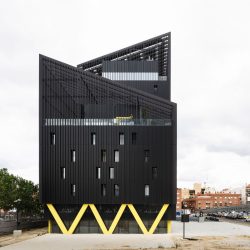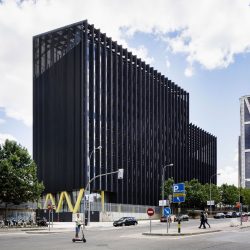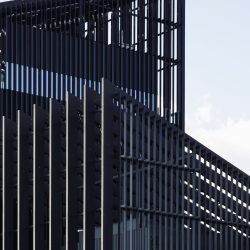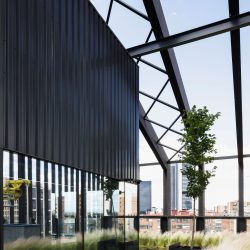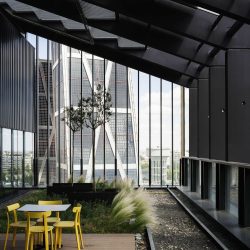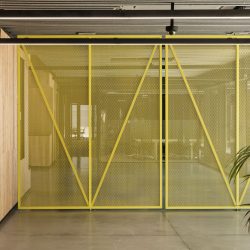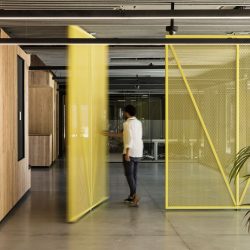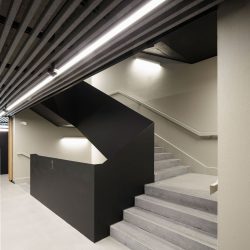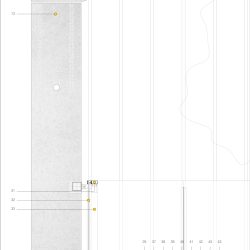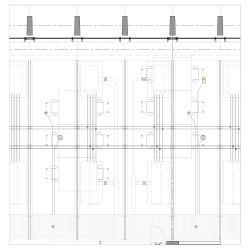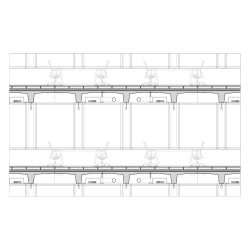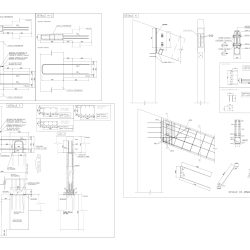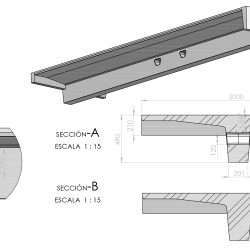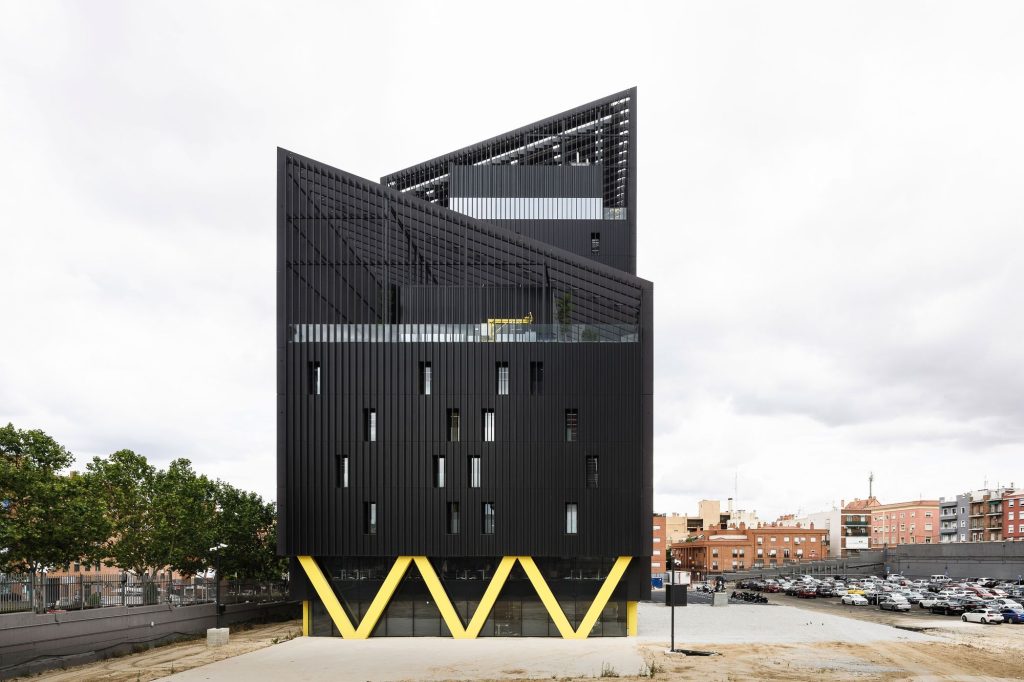
Jardín 1: Nexo Arquitectura + Gutiérrez-delaFuente Arquitectos + Andrés Perea Arquitecto. fotos: © Fernando Alda
The CIT is an initiative by Metro de Madrid to build a Transport Campus on the site of Plaza Castilla (Avenida de Asturias) where the former depots of Line 1 were located. The project has a double objective, on one side the urban regeneration through an existing plot, containing an obsolete Metro facility, and on the other hand the centralization of office spaces and services related to the transport in the Community of Madrid and to the already centennial Metro de Madrid.
Metro de Madrid Transport Complex (CIT): an institutional campus
The new headquarters of Metro de Madrid company are completed (in 2022) as the first component of the Campus (Phase 01).
The CCOR (New Technological and Operational Center), a building for the Regional Transport Consortium and the Museum of Transport will be included in a second phase. All the buildings are framed within the sustainability criteria and the almost zero consumption building standards nZEB.
A new urban acropolis: Metro de Madrid making city
One of the urban projects key, belonging to this institutional acropolis, is the visual and physical permeability which allows the visitor to articulate the relationship between the built, the central garden and the urban context. A new urban structure clarifies the space of the street and the interior Garden. A new habitat for the workers, the neighbours, the visitors but also for the local fauna and flora. The CIT creates a space which Madrileños would remember, a space they would want to come and feel like citizens. A place that does not exist in the environment of Plaza Castilla. Just yet.
Metro de Madrid legacy: a heritage for the future
The central Garden, Jardín 1 Metro (in regard to the old depots of the Metro Line 1) is a new Metro park which maintains the legacy of the old depots space. A new space which talks about the infrastructures that made Madrid a great city, and which reflect a contemporary attitude to restore, to update and to reuse. A contemporary urban archaeology practice based on a circular strategy.
The past of this place will be present in numerous aspects, but it gets its particular importance in the central Garden, built from the depots existing structure and the ”furniture” elements such as the escalators, the mechanical doors, the masts, the railways and many others, keeping their yellow colour of maximum visibility, considered very iconic in the industrial Metro culture. Attention should also be drawn to the recycling of the ballasts deposit, still on the plot, which will be an urban landmark for the main access to the Garden.
The heritage of the place is renaturated and serves up as inspiration. It arises a hybrid landscape in Plaza de Castilla: Jardín 1.
_
Centro Integral del Transporte de Metro de Madrid
1º Premio Concurso en 2 fases, 2016. En construcción, 2019/-
Estructura del primer edificio terminada (Sede de Metro)
Autores del proyecto:
Jardín 1: Nexo Arquitectura + Gutiérrez-delaFuente Arquitectos + Andrés Perea Arquitecto
(Lourdes Carretero, Manuel Leira, Julio de la Fuente, Andrés Perea, Iván Carbajosa)
Cliente:
Metro de Madrid, Comunidad de Madrid
Localización:
Avenida de Asturias, Plaza Castilla, Madrid
Colaboradores:
Equipo Jardín 1: Pasquale Ludovico, Silvia Acera, José Antonio Arias, Teresa Castillo, Javier García, Flavio Martella, Eva Martínez, Marta Guedán, Ignacio Cimadevilla, Alejandro Estébanez, Laura Puchades, José Mª Nuñez (concurso)
Arquitecto técnico: Carrión Arquitectura Técnica
Paisajismo: Batlle i Roig Arquitectes
Estructuras e instalaciones: Valladares Ingeniería, BAC Ingeniería, Aiguasol
Certificación energética: VERDE – GBCe
Coordinación Seguridad y Salud: Safecor
Control Técnico: CPV-CEP Ibérica
Visualizaciones 3D: Three_visual
Maquetas: MaqGil Maquetas, Gilberto Ruiz
Constructora:
Ferrovial Agromán
COMSA
Créditos fotografías:
Reportaje de final de estructura: Fernando Alda
Resto de material, incluidas fotos de seguimiento de obra: Jardín 1
El CIT es una iniciativa de Metro de Madrid para construir un Centro Integral del Transporte en el solar de las antiguas cocheras de Plaza de Castilla (Avenida de Asturias, Madrid), que salió a concurso en 2016 y en el que el equipo compuesto por los arquitectos Lourdes Carretero, Manuel Leira, Julio de la Fuente, Andrés Perea e Iván Carbajosa, resultó ganador. El Centro Integral del Transporte (CIT), un complejo institucional para un nuevo hub del transporte: El proyecto tiene un doble objetivo, por un lado la regeneración urbana a través de un solar que albergaba una instalación metrera obsoleta, y por otro lado la centralización de espacios de oficinas y servicios relativos al transporte en la Comunidad de Madrid y al ya centenario Metro de Madrid. La nueva Sede de Metro de Madrid será la primera pieza del CIT, a la que se unirán el CCOR (Nuevo Puesto de Mando y COMMIT), el Consorcio Regional de Transportes, y el Museo del Transporte. Todos los edificios se enmarcan dentro de los principios de eficiencia y los estándares de edificios de consumo de energía casi nulo Nzeb. Una nueva acrópolis urbana, Metro de Madrid haciendo ciudad: Una de las claves del proyecto urbano, de esta acrópolis institucional, es la permeabilidad visual y física que permite articular la relación entre lo construido, el Jardín central y el contexto urbano. Una nueva estructura urbana que clarifica el espacio de la calle, y el del Jardín interior. Un nuevo hábitat para los trabajadores, los vecinos y los visitantes. El CIT trata de crear un espacio que los madrileños recuerden, al que quieran ir para sentirse ciudadanos. Ese lugar que en el entorno de la Plaza de Castilla no existe. Todavía. El legado de Metro de Madrid, una herencia para el futuro: EL Jardín central, Jardín 1 Metro (en referencia a las antiguas cocheras de la Línea 1) es un nuevo parque metrero que pretende mantener el legado del espacio de las antiguas cocheras. Un nuevo espacio que habla de las infraestructuras que han hecho de Madrid una gran capital, y que plasma una actitud contemporánea de recuperar, actualizar y reutilizar. Un ejercicio de arqueología urbana contemporánea y circularización. La historia del lugar estará presente en múltiples aspectos, pero toma especial relevancia en el Jardín central construido a partir de la estructura existente de las cocheras y sus elementos muebles como son las escaleras metálicas, puertas automáticas, mástiles, vías... que mantienen su color amarillo de máxima visibilidad y tan presente en la cultura industrial metrera. Destacar el reciclaje del depósito de balasto, aún en la parcela, que pasará a ser un hito urbano en el acceso principal al Jardín. El patrimonio del lugar, renaturalizado, sirve de inspiración. Surge un híbrido paisajístico en Plaza Castilla: Jardín 1.

